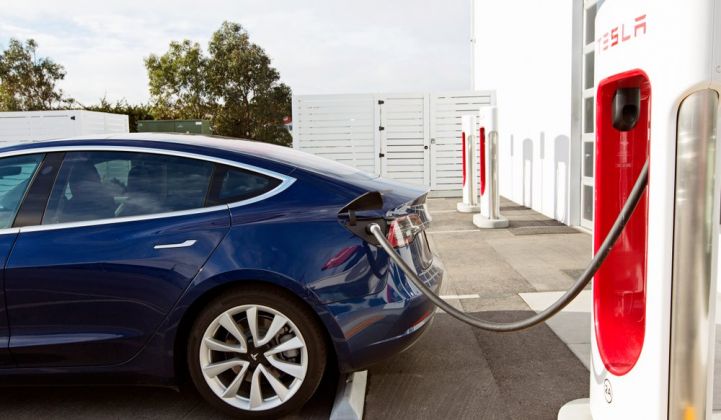Electric vehicle makers and battery manufacturers are making progress in developing new lithium-ion designs, amid persistent concerns over the supply of key materials.
Concerns over cobalt, in particular, are forcing battery makers to move toward cobalt-light lithium-ion formulations, said Hans Eric Melin, founder of Circular Energy Storage, a consultancy focused on battery end-of-life management.
Foremost among these formulations is a lithium nickel-manganese-cobalt (NMC) cathode chemistry with eight parts of nickel for each part of cobalt. This mix, known as 811, is the latest in a line of NMC cathode chemistries where the ratio of cobalt is being reduced in favor of other materials, particularly nickel, which is cheaper and easier to source.
First commercialized by the Chinese battery manufacturer Contemporary Amperex Technology Co. (CATL) at the start of this year, 811 is rapidly gaining ground on two other slightly less low-cobalt variants, NMC 532 and 622.
Some 13 percent of passenger EV batteries sold in China in August had NMC 811 cathodes, up from just 1 percent in January, according to minerals advisory firm Adamas Intelligence. In fact, NMC 811 was second only to NMC 532 in China by passenger EV battery capacity deployed, leapfrogging NMC 622.
The rapid rise of 811 in the Chinese market is largely due to CATL supplying batteries for popular EV models, said the consultancy.
“With CATL continuing to forge new supply agreements, and other key Asian cell suppliers at the outset of commercial production, we expect the market share and global footprint of NMC 811 will expand substantially over the coming 18 to 24 months,” Adamas Intelligence said.
Moving beyond cobalt
Some automakers have already moved beyond 811, however.
Tesla, for example, uses a nickel-cobalt-aluminum oxide cathode that contains “substantially less cobalt than the industry-standard batteries based on a nickel-manganese-cobalt oxide chemistry,” according to the company’s 2018 Impact Report.
“Tesla not only uses far less cobalt per vehicle than the rest of the electric vehicle industry but also plans to recycle and reuse the cobalt at these batteries' end of life,” stated the company.
Tesla wants to altogether eliminate cobalt, which is mostly sourced from the politically volatile Democratic Republic of Congo and often dug up under precarious conditions by artisanal miners.
But getting rid of cobalt is easier said than done. It is important in enhancing the energy density of lithium-ion batteries and enabling them to power electric vehicles. For less energy-dense applications, there are already chemistries, such as lithium-iron-phosphate, that don’t need cobalt.
Aceleron, a British company supported by Shell Ventures, has created a lithium-iron-phosphate battery that can be serviced and reused as easily as a lead-acid equivalent, reducing the likelihood of the batteries going into a landfill and further curtailing materials losses in the supply chain.
Aceleron’s batteries are primarily designed for off-grid stationary storage applications in places such as the Caribbean and sub-Saharan Africa.
“We’ve designed the batteries so they can be taken apart in places where they don’t have high-tech components,” said Amrit Chandan, Aceleron’s co-founder and CEO.
In applications where cobalt-based batteries are still required, the search continues for ways to reduce the amount of metal needed per battery, even in low-cobalt variants.
This July, for example, saw the completion of a European cobalt-cutting project called ECO COM’BAT, led by the German research body Fraunhofer ISC in collaboration with other institutes, materials producers including Arkema and Umicore, and battery manufacturers such as Saft.
The project focused on NMC 622 batteries and was able to cut cobalt requirements by 20 percent using a special electrode coating and a high-voltage electrolyte. These improvements could in theory be applied to 811 batteries as well, said Andreas Bittner of Fraunhofer ISC.
ECO COM’BAT also looked at recovering materials after use through recycling. The outcome was a process by which battery materials can be extracted rapidly in water. Then one "can separate and sort them very easily with simple physical methods,” Bittner said.
“The materials can be recycled in a chemical way very easily because you don’t have to treat the whole volume of the battery, and all materials are accessible for the chemicals,” he said. Alternately, “You can refine the materials and reuse them directly for the production of new electrodes.”
Elsewhere, there is also interest in recovering materials lost during the manufacturing process.
A company called PowerTech Water, from Lexington, Kentucky, this month bagged $1.5 million in Series A funding to commercialize a system that can capture cobalt, manganese and other metals in lithium-ion battery manufacturing wastewater.
Interest in such processes, along with growing levels of lithium-ion battery recycling in China and the rapid growth in chemistries such as NMC 811, indicate that the battery industry is taking the threat of cobalt shortages very seriously.
As a result, predicted Melin of Circular Energy Storage, “The dependency on cobalt will in fact be lessened much faster than we could [have] expected.”




